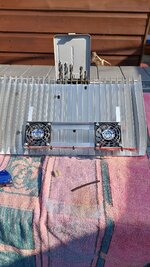Thanks for this tonkaPics attached if they help anyone to understand it more..
Just for clarity, your last pic shows the thermal paste in it's 'syringe ', I'm presuming you dispense it direct from the syringe on to the coolant tubes?
If so, do you aim for a specific thickness of 'bead' all the way along the tubes, or did you just back and forth until the syringe was empty?
Sorry if it's a numpty question
Barry




